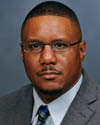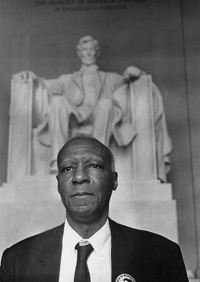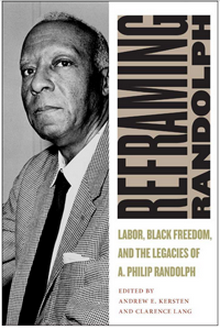Book reflects on mixed record of civil rights, labor movement leader
LAWRENCE — The complicated legacy of one of the country’s great civil rights leaders, A. Philip Randolph, is examined through a collection of essays co-edited by a University of Kansas professor.
Eclipsed by Martin Luther King Jr., Randolph was one of the most influential African-American civil rights and labor voices from the 1920s to the 1960s. Randolph formed the first African-American labor union to sign a collective bargaining agreement with a major company, organized the 1941 March on Washington Movement and was a key figure in the 1963 March on Washington, which is best known for King’s “I Have a Dream” speech.
 “For a good part of the 20 century, Randolph was both the leading African-American labor and civil rights leader,” said Clarence Lang, associate professor of African and African-American studies. “He embodied two political strands that are often thought of in opposites terms: struggles around race and struggles around class.”
“For a good part of the 20 century, Randolph was both the leading African-American labor and civil rights leader,” said Clarence Lang, associate professor of African and African-American studies. “He embodied two political strands that are often thought of in opposites terms: struggles around race and struggles around class.”
Lang, with Andrew Kersten, dean for the College of Letters, Arts and Social Sciences at the University of Idaho, edited the book “Reframing Randolph: Labor, Black Freedom, and the Legacies of A. Philip Randolph,” which New York University Press is releasing this month. In the book’s collection of essays, established and emerging scholars offer diverse accounts of Randolph’s mixed record on labor and civil rights, as well as his gender politics and changing views of religion.
“Randolph is the most consistent black labor and civil rights activist of the 20th century, but he is also deeply flawed,” Lang said.
 In the 1920s, Randolph organized the Brotherhood of the Sleeping Car Porters, which signed a collective bargaining agreement with the Pullman Company in the late 1930s and was the first black-led union to receive a charter from the American Federation of Labor. Railroad porters were often well-educated African-Americans who were highly respected in their communities; however, the job offered little pay for long hours and was reminiscent of black servitude.
In the 1920s, Randolph organized the Brotherhood of the Sleeping Car Porters, which signed a collective bargaining agreement with the Pullman Company in the late 1930s and was the first black-led union to receive a charter from the American Federation of Labor. Railroad porters were often well-educated African-Americans who were highly respected in their communities; however, the job offered little pay for long hours and was reminiscent of black servitude.
“It was a long fight and a violent struggle. And, there were periods when the union was on the verge of collapsing,” Lang said. “But they kept the faith so by the 1930s there were general improvements in terms of pay, working conditions and recognition of their individuality.”
In 1941, Randolph organized the March on Washington Movement to protest a segregated military and to advocate fair working opportunities for African-Americans in the World War II defense industries. The movement resulted in Executive Order 8802, which banned discrimination in the defense industries and created the Fair Employment Practices Commission. In 1948, President Harry Truman, through an executive order, banned racial segregation in the armed forces.
Later in his career, Randolph drew criticism from younger African-American activists for siding with the labor movement at the expense of civil rights progress. During the 1968 New York City teachers’ strike, Randolph backed a mostly white teachers’ union over African-Americans fighting for community-controlled schools. Randolph also remained loyal to the American Federation of Labor-Congress of Industrial Organizations (AFL-CIO) at a time when younger African-Americans were protesting the organization’s racist policies and pushing to break away.
 “In his own way, he was being consistent and true to his values as a labor unionist,” Lang said. “But it became harder to reconcile those commitments with the commitments to civil rights at a time when the agendas of those two movements were colliding. He tended to side toward what was familiar, which was organized labor.”
“In his own way, he was being consistent and true to his values as a labor unionist,” Lang said. “But it became harder to reconcile those commitments with the commitments to civil rights at a time when the agendas of those two movements were colliding. He tended to side toward what was familiar, which was organized labor.”
Once a household name, Randolph’s legacy has been forgotten with the decline of the country’s labor movement. Lang said the idea to focus on Randolph’s work was inspired during a time when the Occupy movement and labor protests in Wisconsin were receiving national attention.
“Among scholars, Randolph is fairly well-known, but not in the general public. So we wanted to use this project as a jumping off point to reassert his prominence,” Lang said. “We thought a lot about what would Randolph do in these situations to bring together issues that involve race as well as class.”